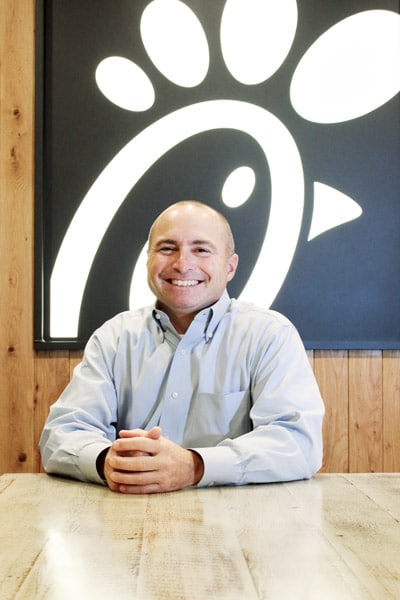 When heavy rains began to fall on Baton Rouge, Louisiana, in August 2016 and flooding became an imminent threat, David Millican says he and other Chick-fil-A employees kept an eye on the news and immediately began putting a plan into place.
When heavy rains began to fall on Baton Rouge, Louisiana, in August 2016 and flooding became an imminent threat, David Millican says he and other Chick-fil-A employees kept an eye on the news and immediately began putting a plan into place.
“On Thursday we were talking with each other, ‘If this storm happens, what do we do?’” says Millican, who is senior director of restaurant development, facilities, and equipment for the Atlanta-based national quick-service restaurant chain. “On Friday, we were actually making hotel reservations in an area where we thought the storms would hit. . . . We were ready: Our contractors and our folks were there waiting on the front line for FEMA to allow us to go into those areas.”
When they received the go-ahead, the Chick-fil-A team poured in to take care of its affected restaurants in the area. Millican says several stores were without power, but two locations in particular took the brunt of the storms and flooding.
“We had one location with over three feet of water in the entire store,” he says. “We totally gutted the interior, took out every piece of equipment, replaced it, and six days later, had that store open and ready for business. We were the only quick-service restaurant in a five-mile radius that was open.”
The anecdote speaks to the company’s willingness not only to take care of its own, but of those it serves. Part of Chick-fil-A’s corporate purpose is to have a positive influence on all who come into contact with the company, and that’s the part that Millican says he most enjoys about the job.
“No matter whether I’m in an airplane flying across the country, or standing in a store working with the local owner/operator, or communicating with a partner or vendor, I love the part of this positive influence,” he says. “It gives you a great platform and opportunity to invest in people.”

That investment is only extending its reach throughout the country. When Millican joined Chick-fil-A in 2010, he says the company was valued at about $3 billion. Now he says that figure has more than doubled to nearly $7 billion, and as the company continues to expand into new territories, it’s also working to balance the high amount of traffic at each of the locations.
Millican says the company has groups dedicated to determining how best to manage capacity issues at its existing locations and identify how best to handle increased traffic at new locations, but that in itself presents a unique challenge.
“We’re very fortunate that we’re extremely busy,” he says. “But you can’t stop the organization and go, ‘OK, I’m going to figure this out.’ When we build a new store, you can take what you’ve learned and put it into the restaurant. But how do you go back when you’re tweaking, testing, and learning these solutions to put them into older locations?”
Some solutions for new locations—multilane, canopied drive-throughs, and expanded seating options, for example—aren’t as easy to tweak in some of the older locations, but Millican says the Chick-fil-A team works tirelessly to make sure its customers are happy and that service remains efficient. He also credits his work before joining the company for preparing him for these kinds of transitions.
“I came from a smaller family business in the construction industry,” he says. “For 20 years, I learned about the profit side of the equation and the work you have to do to grow a business, and I’ve tried to use that knowledge in growing this department.”
Referencing management guru Peter Drucker’s famous quote that “culture eats strategy for breakfast,” Millican says the investment Chick-fil-A makes in serving its employees and making itself a part of the communities in which it builds is a foundational part of its continued success.
That’s not to say the company shies away from strategy or innovation. Millican says that since the beginning, leadership in Chick-fil-A’s facilities management group has been forward thinking. Over the department’s history, it pioneered such initiatives as data collection, new outsourcing models, and restructuring to meet market-level needs. It’s also currently working to transform the department from budget reporting to budget forecasting as part of a revamped budgeting process based on historic data analysis and trend indicators. Nevertheless, he says, these efforts are never done at the expense of the company’s interpersonal relationships inside and outside the restaurant doors.
“It takes time to build culture and community in your group,” he says. “All the strategy and innovation you have is very important, but sometimes, we as leaders don’t slow down enough to allow the culture and community to be built into a cohesive team. I believe doing that will eat strategy for lunch every time.”
David Millican on Managing Growth
Design and Location
“The design standards that are paramount to new locations center around the ability to create operational efficiency, team member comfort, and a consistent customer experience. Our new restaurant designs incorporate some distinctive visual elements that are a nod to our company heritage (e.g. community tables, peach basket lights). In terms of location selection, our goal is that Chick-fil-As are convenient for our customers. We are constantly striving to achieve designs that balance the needs of our guests who are pedestrians as well as the needs of our guests who are in their vehicles.”
Urban Expansion
“Increasingly, as we move into more urban areas, developing new locations involves repurposing existing buildings. This presents an interesting challenge where we often have to rethink the way we have created restaurant environments in the past. For instance, one of our Manhattan restaurants is three floors, where the cooking happens in the basement and the dining room is on the top floor.”


